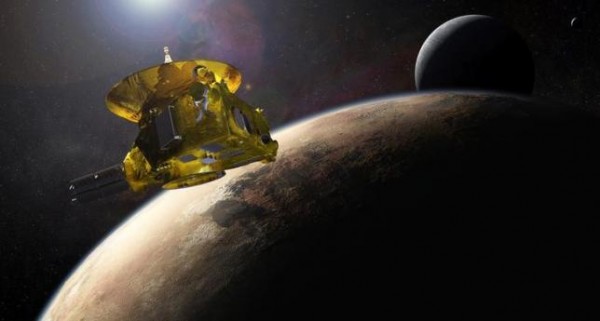By Lynn Palec, | March 23, 2016

An artist's impression of NASA's New Horizons spacecraft encountering Pluto and its largest moon, Charon.
It has been several months since the New Horizons space probe made its historic flyby of Pluto and now new images are coming in which have shocked the science community. One of the latest transmitted photos suggest the presence of frozen liquid nitrogen on the dwarf planet's surface.
The possible presence of liquid on Pluto's surface have baffled scientists. First, average temperature on the planet's surface could easily exceed -400 Fahrenheit. According to National Geographic, the team working on the New Horizons project is slowly learning that Pluto is not a dead planet after all, contrary to original suggestions.
Like Us on Facebook
Scientists from the National Aeronautics and Space Administration (NASA) believe that changes in Pluto's atmospheric pressure may have resulted in the presence of the frozen mass of liquid slowly thawing on the surface.
In a statement acquired by Science Alert, New Horizons principal investigator Alan Stern said, "Liquids may have existed on the surface of Pluto in the past. We see what for all the world looks to a lot of our team like a former lake."
Pluto takes 248 years to orbit around the sun. As Pluto completes its orbit, it experiences some of the most extreme season shifts in the solar system. When scientists try to simulate these seasonal changes taking into account how Pluto's title can wobble, they found out that the nitrogen atmosphere of the dwarf planet becomes dramatically thicker and thinner over millions of years.
The exact event when this frozen liquid nitrogen melts was estimated by scientists to have took place at least 800,000 years ago when the Pluto's axial tilt reached 103 degrees. Scientists believe that Pluto is currently in an intermediate phase between its climate extremes. This means that it will take a very long time before this event happens again.
What really excites scientists is the fact that New Horizons have only transmitted half of all its captured data about Pluto. Scientists are very keen to know the rest of the data in order for them to release a solid conclusion regarding their theories about the dwarf planet.
The New Horizons team recently delivered 40 scientific papers at the Lunar and Planetary Science Conference based on the data transmitted by the space probe.
-
Use of Coronavirus Pandemic Drones Raises Privacy Concerns: Drones Spread Fear, Local Officials Say

-
Coronavirus Hampers The Delivery Of Lockheed Martin F-35 Stealth Fighters For 2020

-
Instagram Speeds Up Plans to Add Account Memorialization Feature Due to COVID-19 Deaths

-
NASA: Perseverance Plans to Bring 'Mars Rock' to Earth in 2031

-
600 Dead And 3,000 In The Hospital as Iranians Believed Drinking High-Concentrations of Alcohol Can Cure The Coronavirus

-
600 Dead And 3,000 In The Hospital as Iranians Believed Drinking High-Concentrations of Alcohol Can Cure The Coronavirus

-
COVID-19: Doctors, Nurses Use Virtual Reality to Learn New Skills in Treating Coronavirus Patients











